Tuco-tucos, Ctenomys spp.,
are small South American Rodents which live their entire lives underground
within underground burrow systems, never venturing to the surface. Studies of
other Rodents with similar lifestyles, such as the Pocket Gophers of North
America, have found that their burrows tend to form unique ecosystems with
distinctive faunas of Insects and other small invertebrates.
In a paper published in the journal Zootaxa on 8 April 2015,
François Génier of the Canadian National Collection of Insects, Arachnids andNematodes at Agriculture and Agri-Food Canada, describes a new species of
Scarab Beetle discovered during an investigation into the fauna of Tuco-tuco
burrows at low elevation in Santa Cruz de la Sierra province, Bolivia.
The new Beetle is placed in the genus Ctenomys, and given the specific name cujuchi, a local name for Tuco-tucos. These are glossy black Scarab
Beetles 4.3-6.0 mm in length, with coarsely punctate pygidia (dense patterns of
pits on their backs between the heads and wings).
Ateuchus cujuchi in (1) dorsal and (2) ventral views. Génier(2015).
See also…
There are currently eight species of Scarab
Beetles in the genus Scapanoclypeus,
which is known from Namibia and western South Africa. They are...
 A new species of Scarab Beetle from the Elandsberg Mountains of the Western Cape, South Africa. Scarab Beetles of the genus Trichostetha occur across southern Africa, reaching their greatest diversity in...
A new species of Scarab Beetle from the Elandsberg Mountains of the Western Cape, South Africa. Scarab Beetles of the genus Trichostetha occur across southern Africa, reaching their greatest diversity in... A new species of Scavenger Scarab Beetle from the Early Cretaceous of Liaoning Province, China. Scavenger Scarab Beetles (Hybosoridae) are small (5-7 mm), oval Scarab
Beetles, with enlarged mandibles and mouthparts. They are typically
carrion feeders, with some species favouring vertebrate dung. They are
not a large group of Beetles, with only about 600 species...
A new species of Scavenger Scarab Beetle from the Early Cretaceous of Liaoning Province, China. Scavenger Scarab Beetles (Hybosoridae) are small (5-7 mm), oval Scarab
Beetles, with enlarged mandibles and mouthparts. They are typically
carrion feeders, with some species favouring vertebrate dung. They are
not a large group of Beetles, with only about 600 species...
Follow Sciency Thoughts on Facebook.


